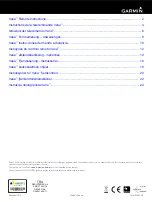
6
−
Strap on your
helmet that meets
ASTM o
r CPSC
safety testing
requirements
−
Have reflectors
and lights
installed on your
bike
−
Use proper hand
signals
−
Avoid loose clothing
−
Ride on the correct side of the roadway with flow
of
traffic
−
Always wear bright color and reflective clothing
−
Ride single file if riding with others
−
Obey all traffic laws and regulations and traffic
signals
−
Watch for parked car doors opening unexpectedly
−
Watch for pedestrians stepping out, pets and
children playing near roadways
−
Keep a safe stopping distance between you and
other
vehicles
−
Never carry a passenger
−
Never ride with earbuds or headphones
−
Use caution when crossing railroad tracks and
carefully cross at a 90 degree angle
−
Mount a horn or bell on to your bike to signal
others of your approach.
Braking
Your bike is equipped with two hand brakes.
One hand brake operates
the front brake
and
the other operates
the rear. Take time to
familiarize yourself
with
which
h
and
brake
stops each
wheel. You can
complete this task by
spinning the front
wheel and squeezing
each brake lever one at a time to determine
which one stops the wheel from spinning; this
would be your front brake.
When preparing to slow down or stop, gently
apply
both front and rear hand brakes at the same
time being careful not to
over apply the front
brake which could cause
you to lose control and
fall.
Before riding your bike
for the first time please
follow the "Brake Burn in Procedure" in your owners
packet. For more information on your brakes, please
review the Tektro brakes manual in your owners
packet.
Shifting
Your Bike is equipped with a twist shifter located on
the left side of your handlebar.
Twisting the shifter forward will move your
dérailleur to the left causing your drivetrain to switch
to a larger gear. The larger gear will give your bike
more torque and less speed.
When climbing hills always shift to a larger sprocket
to give your bike more torque.
Twisting the shifter back will move your derailleur to
the right causing your drivetrain to switch to a
smaller gear. The smaller gear will give your bike
more speed and less torque.
Only shift one gear at a time. Shifting several gears at
once will move the dérailleur faster than the chain,
causing damage to drivetrain system.
For more information about shifting, please review
your SRAM manual in your owner's packet.
NEVER shift gears while using the motor at the same
time. This can cause damage to your drivetrain
system.
For more information on shifting review your SRAM
manual in your owners packet.
WARNING
!
Avoid applying sudden or excessive force to the
front brake system. Doing this can cause your front
wheel to lock up and your rear wheel could lift up
and lose contact with the ground. Slide your
weight back on the seat and apply pressure to both
the front and rear brakes at the same time.
SECTION 2 - GENERAL RIDING INFORMATION
Once you have inspected your bike and all
components are in proper working condition, you
are ready to test ride your new bike. A few
important general rules for riding
in
clude
but are not limited to:



































